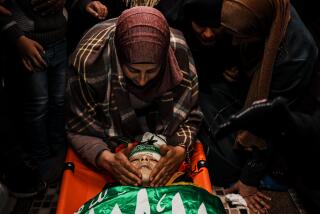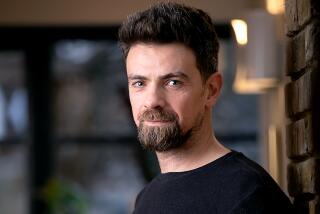A Regression in Time : Plunge off a bridge lands photographer in wartime India : LOOKING THROUGH GLASS, <i> By Mukul Kesavan (Farrar, Straus & Giroux: $25; 374 pp.)</i>
- Share via
On his way to tip his lordly and ascetic grandmother’s ashes into the holy Ganges--”Dadi hated leftovers”--the narrator’s train halts on a high bridge near the north-India city of Lucknow. An avid photographer, he climbs out on a catwalk to try for a spectacular shot. Narrator, camera and Dadi suddenly plunge through space.
They have plunged through time, as well. The young man comes to in an amiably decayed Lucknow mansion, where he is tended lovingly by the family: Ammi, the matriarch, her son, Mahroor, who found him and brought him home, Asharfi, the daughter, and an old family friend, Haasan. It is no longer the 1990s but 1942.
Wartime India is ruled by the British, and Gandhi has joined the Congress Party in endorsing a Quit India campaign. It will lead to violence, to the arrest of Gandhi and the Congress leaders and, most fatefully, to the alienation of those moderate Muslims who had been their allies. Five years later the horrors will arrive: a partitioned nation and, in the process, 500,000 killed and 16 million Muslims and Hindus fleeing respectively to the new Pakistan from India and the other way.
The time regression is magical, technically, but the magic that Mukul Kesavan practices in his first novel, “Looking Through Glass,” is of a different and superior order. It lies in his ability to evoke the tragedy, comedy and above all the humanity of a terrible epoch. From 1942 to 1947, the book’s span, his narrator relives as his vital present a history that took place long before he was born, and whose outcome he knows.
It is much more than a time-travel trick. The narrator’s pain is double. It is not just in what will become of Ammi, Haasan, Asharfi, Masroor and Haasan, but in what has already become of them. For us, the past may be terrible and known, but at least it’s over. The future may be terrible and still to come, but at least it’s not known. The narrator has to refract the agony of both, without their respective easements.
The way he does it is a world away from gravity or somberness. He treats his own adventures through India of the 1940s, and the pain and foreboding as well, with the same picaresque relish that he finds in the adventures of those around him.
There is an attempted train derailment, an elephant ride with a band of Hindu nationalists charging a police station, the disastrous attempt of a pornographer to film the Kama Sutra, and a lesbian love affair. There is the hapless irony that befalls Haasan who, despite his name and his honorary uncle-status in Ammi’s family (Moslem, though as we shall see, paradoxically so), is a Hindu. As a young man and itinerant food peddler, he disguised himself as a Moslem to make his way through a dangerous stretch of country, only to have an extremist Hindu gang jump him and carve a swastika on his chest.
There is the story of the ancient Hindu family of the Ganjoos. An ancestor established the family fortunes by betraying Lucknow to the British in the 19th Century. His grandson rose to magnificence as a very senior civil servant. His son fell in love with Urdu poetry, converted to Islam, married a Muslim and departed for Mecca. He left behind Ammi, his wife--who, years later, still awaits his return--and his children, Masroor and Asharfi.
There is the decision of an aristocratic Hindu matron--it is Dadi, whom the narrator meets just after dumping her ashes in the Ganges--to follow Gandhi’s example by dressing her household in homespun cloth. She weaves, badly, a set of robes for her husband, a distinguished Delhi judge, who wears them despite their odd look. “He always respected conviction in public life and never once did he complain,” Kesavan writes. But he drew the line when Dadi wanted to replace the traditional Morocco binding on his law books. “Principles untempered by precedent amounted to zealotry, not idealism,” the judge ruled.
Kesavan infuses English with a particular cadence that makes it start up, as if someone had dusted pepper on its tail, and move in ways it is not used to. He will take a dead phrase and bring it to condimented life. The narrator is downcast when Dadi fails to recognize him when he turns up in Delhi, years before his birth. She is snobbish and cool. “Life didn’t look up. Blood didn’t tell,” he remarks. The English of other Indian writers--Salman Rushdie’s, for instance--has such a piquancy, sometimes. Language is a way of knowing ourselves. Their jauntiness allows us to know ourselves differently.
It can, for instance, voice tragedy. In 1943, Ammi’s family stops in Delhi, where the narrator has found work as a waiter at a posh hotel. Famine has hit the countryside; corpses have appeared in Lucknow, but Ammi insists that it is not starvation but the plague. They are headed for Simla, a hill retreat where the British and upper-class Indians go to beat the heat.
During their brief visit, the narrator hears a table full of British officers talking about “Archie”: bluff barracks parlance for the new viceroy, Field Marshal Sir Archibald Wavell. The narrator recites the term--varying it with “the knight Archibald”--in mockery. Then, passing Wavell’s portrait in a line of viceregal portraits, he realizes there will be only one more--Lord Mountbatten’s--before the catastrophe of independence and massacre.
“Time was revving up. It wouldn’t take long to use up the four years before August 1947.” He wants to convince Ammi’s family to stay in Simla until then. “But how? What was the master argument? . . . I needed the answer quickly because between Archie and the edge there was just one more space on the wall.”
The episodes, many playful, and most of them possessing the joy in realistic detail that was the glory of the 19th-Century Western novel, never get far from the book’s theme. A rich and varied civilization, to which Hindu and Moslem traditions both contributed despite often bloody tensions, may or may not have survived had the politics been different. I don’t believe that Kesavan is affirming that it would have. What he does show is how the politics worked to rip it apart.
Evil is best shown by depicting the suffering of the good. “Looking Through Glass” has a whole gallery of rogues and fanatics, none of whom lack a measure of the author’s affection. There are a number of saintly figures, as well; two of whom are unforgettable creations.
Ammi is a feminist in her own way--she puts out an irregular cultural magazine for women, and writes all the articles and letters herself because a world that gives women no place has to be invented. Politically, she is a traditionalist. Startling her family, she runs for a woman’s seat against the candidates of both the Hindu Congress and the Muslim League. Her “Society for the Defense of the Present” has 12 planks, all of them “don’ts.” No new names for roads, no new laws, new statues, dismantling of statues and so on, for five years after independence “ ‘til we sort out what we want to keep from what they leave behind.”
Masroor, her son, is an extremist in the cause of moderation. He tries to derail a train because it is carrying a Hindu cricket team to play a Moslem team. For the British governor, cricket unquestionably brings peace. Masroor knows otherwise:
“There are still occasions when large numbers of Hindus and Muslims gather in public and mix uninhibitedly without restraint or any thought for normal social distance. . . . We call them riots.”
We last see the family during the partition civil war. Leaving the protection of a Muslim refugee camp outside Delhi, they head back to Lucknow and an uncertain fate. Presumably the narrator gets back to the 1990s, though we are not told how. The point of this lavish and stirring book is not time travel, but how our lives hop and limp through the humanity of time and the inhumanity of history.
More to Read
Sign up for our Book Club newsletter
Get the latest news, events and more from the Los Angeles Times Book Club, and help us get L.A. reading and talking.
You may occasionally receive promotional content from the Los Angeles Times.









